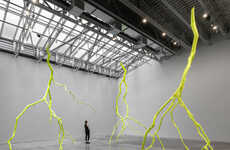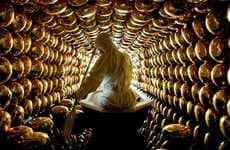
Janet Echelman's Art is Inspired by the Forces of Nature
Meghan Young — June 17, 2011 — Tech
At first glance, Janet Echelman's work may look like light graffiti to you, I know it did to me. That is what makes her sculptures so beautifully astounding. What looks like just strategically captured vibrant lights and insubstantial shapes are actually very real and touchable.
Unlike any sculpture I have ever seen before, Janet Echelman's art installations look like the forces of nature that they were inspired by. From wind, water and light, each sculpture takes on an organic form that nevertheless looks quite futuristic as well.
Combining ancient craft with cutting-edge technology, Janet Echelman creates permanent sculptures that are at the scale of buildings. I swear that if you came across any one of her creations, you would instantly become lost in its mesmerizing depths.
Unlike any sculpture I have ever seen before, Janet Echelman's art installations look like the forces of nature that they were inspired by. From wind, water and light, each sculpture takes on an organic form that nevertheless looks quite futuristic as well.
Combining ancient craft with cutting-edge technology, Janet Echelman creates permanent sculptures that are at the scale of buildings. I swear that if you came across any one of her creations, you would instantly become lost in its mesmerizing depths.
Trend Themes
1. Light Graffiti Sculptures - The trend of using light to create immersive and visually stunning sculptures, blurring the line between art and technology.
2. Forces of Nature Inspired Art - A trend in creating art installations that mimic the organic shapes and movements found in nature, bringing a sense of awe and connection to the viewer.
3. Combining Ancient Craft with Technology - The trend of merging traditional craftsmanship with modern technology to create large-scale and visually captivating sculptures that push the boundaries of what is possible.
Industry Implications
1. Art and Design - Artists and designers have the opportunity to explore new techniques and materials that incorporate light and natural forms into their work, creating unique and engaging experiences for viewers.
2. Architecture and Construction - Architects and construction professionals can explore the use of light and organic shapes in their structures, creating visually stunning and environmentally-conscious buildings that blend seamlessly with their surroundings.
3. Technology and Innovation - The technology and innovation industry can develop new tools and materials that allow for the creation of larger and more intricate light sculptures, pushing the boundaries of what is possible in the realm of art and design.
6
Score
Popularity
Activity
Freshness























